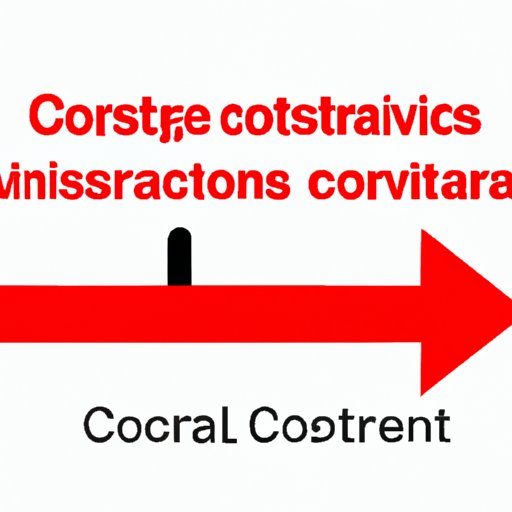
Introduction
Every business owner wants to maximize their profits and minimize their costs. One important tool that can help achieve this goal is understanding contribution margin. Contribution margin is a crucial metric for any business, regardless of its size or industry. In this article, we will explore how to find and calculate contribution margin, including the key elements of variable costs, sales revenue, contribution margin ratio, fixed costs, and break-even point.
Defining Contribution Margin
Contribution margin is defined as the difference between a product’s revenue and its variable costs. It is the portion of sales revenue that contributes to covering the fixed costs of a business and generating profit. Contribution margin is an essential metric because it allows businesses to determine the profitability of each product and make informed pricing and production decisions.
It’s important to note that contribution margin is different from net income, which is the total revenue minus all costs, including fixed costs, and taxes. Contribution margin only takes into account the variable costs associated with producing a product.
Determining Variable Costs
Variable costs are costs that change with the level of production. These costs include materials, labor, and other costs associated with producing a product. Examples of variable costs depend on the type of business, but for a clothing retailer, variable costs may include the material costs and labor required to produce the clothes.
Calculating variable costs is essential to determine contribution margin. To determine the variable costs of a product, you need to add up all the costs associated with producing it. For example, if a clothing retailer produces a certain shirt, its variable costs may include the cost of the material, the labor required to produce it, and packaging costs, among others. Adding up all these costs will give you the variable cost of that shirt.
Calculating Sales Revenue
Sales revenue is the total amount of money a business generates from selling its products or services. There are different types of sales revenue, such as gross revenue, net revenue, or operating revenue. It’s important to understand which type of sales revenue you are using to calculate contribution margin, as they vary in the way they incorporate costs.
To calculate sales revenue, you need to multiply the number of products sold by their price. For example, if a clothing retailer sells 50 shirts at $20 each, their sales revenue for that product would be $1000.
Computing Contribution Margin Ratio
The contribution margin ratio is defined as the contribution margin divided by sales revenue. The ratio represents the percentage of sales revenue that contributes to covering fixed costs and generating profit. It is an important metric to determine how well a product is performing and how it contributes to the overall profitability of the business.
Calculating the contribution margin ratio is straightforward. Divide the contribution margin by the sales revenue of a product, and then multiply by 100 to get the percentage. For example, if the contribution margin of a product is $200 and its sales revenue is $1000, the contribution margin ratio is 20%.
Understanding Fixed Costs
Fixed costs are costs that do not change with the level of production. They include expenses such as rent, salaries, and insurance. Fixed costs are necessary for a business to operate, and they need to be covered by the contribution margin of the products sold.
Understanding fixed costs is important to determine the break-even point, as we will discuss in the next section. Fixed costs need to be covered by the total contribution margin of the products sold to ensure that the business is profitable.
Discussing Break-Even Point
The break-even point is defined as the point at which a business generates enough sales revenue to cover its fixed and variable costs. At the break-even point, a business is not making any profit, but it is not losing money either. It’s an essential metric for businesses to determine how many units of a product need to be sold to cover their costs and start generating profit.
Calculating the break-even point requires knowing the fixed costs, variable costs, and sales price per unit of a product. Once you know these, you can use a simple formula to calculate the break-even point. The formula is:
Break-even point = Fixed Costs / (Sales price per unit – Variable costs per unit)
Knowing the break-even point allows business owners to make informed decisions about their pricing, production, and sales strategies. They can determine which products are profitable and which ones need to be adjusted or discontinued.
Real Life Scenario
Let’s say John owns a small bakery and wants to determine the contribution margin of his blueberry muffins. John knows that the sales price of each muffin is $2, and the variable costs associated with producing one muffin are $0.50. Therefore, the contribution margin per muffin is $1.50 ($2 – $0.50).
John also knows that his monthly fixed costs, including rent, utilities, and salaries, are $1500. He wants to determine the number of blueberry muffins he needs to sell to break even. Using the formula mentioned above, we can calculate the break-even point for John’s blueberry muffins:
Break-even point = $1500 / ($2 – $0.50) = 1000 muffins
This means that John needs to sell at least 1000 muffins each month to cover his fixed and variable costs and start generating profit. By comparing the break-even point of his muffins with the actual number of units sold each month, John can make informed decisions about his production and sales strategies.
Conclusion
Understanding contribution margin is essential for businesses to make informed decisions about their pricing, production, and sales strategies. By knowing the key elements of contribution margin, such as variable costs, sales revenue, contribution margin ratio, fixed costs, and break-even point, business owners can determine the profitability of their products and adjust their strategies accordingly. We hope this article has provided valuable insights into finding and calculating contribution margin and encourages you to use this knowledge to improve your business decisions.




